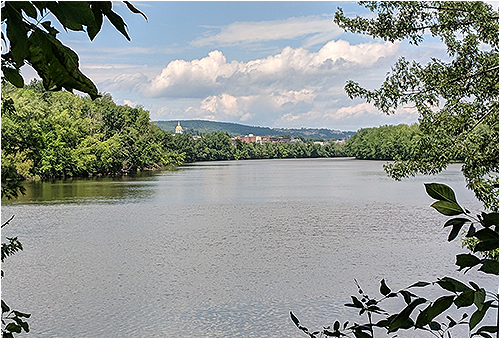Merrimack River

(Text from New Hampshire Dept. of Environmental Services website)
The view from the Upper Merrimack River includes bluffs, farms and fields, forests, and wetlands. This diverse landscape serves to enhance the scenic characteristics of the river, as do the historic and picturesque villages of Penacook and Canterbury and the many unique bridges which cross the river. In the vicinity of Boscawen, a church steeple rises against a backdrop of wooded hills, with a rare view of Mt. Kearsarge, while the capitol dome and church steeples of Concord provide a striking view down river.
As one of New England’s major north-south running rivers, the Upper Merrimack River serves as an important migratory route for waterfowl and songbirds. These species are dependent on the variety of habitats associated with the river including protected oxbows (in Canterbury and Concord) and associated wetlands, backwaters, marshes, cornfields, mixed upland forests, pastures as well as the river itself. The river’s banks provide nesting sites for the bank swallow and the kingfisher. Its corridor provides significant wintering habitat for the federally-listed threatened bald eagle, and is seasonally important to the state-listed threatened osprey. Herons and ducks are also dependent on the river for their livelihood.
The river corridor supports six ecologically significant natural communities including the only inland dunes in the state. Other important natural communities include three occurrences of sandy river bluff forest, a mesic riverbluff forest, an acidic riverside seep community, and floodplain forest communities. Pitch pine/scrub oak barrens also exist along the river, though have been extensively degraded by development. This globally rare community which depends on fire to continue, is important to the survival of a variety of butterflies and moths.
Canoeing is a popular boating activity on the Upper Merrimack River. The river offers both quickwater and flatwater experiences for canoeists as well as short stretches of whitewater, including rapids in the vicinity of the breached dam at Sewalls Falls. The Merrimack River Watershed Council sponsors a variety of canoe trips on the Merrimack and its tributaries throughout the spring, summer and fall for beginner and intermediate paddlers. There are nine public access points to the river for boaters, including those at Franklin High School, Jamie Welch Park in Boscawen, Penacook Treatment Plant and Sewall’s Falls Dam in Concord. More are planned on properties that have been purchased by the riverfront communities.
The river is a cold water fishery that provides habitat for at least 19 resident species, including eight species of sport and recreational importance. The NH Fish and Game Department regularly stocks the Sewalls Falls area and tributary streams with brook and rainbow trout. The New England River Protection and Energy Development Project ranked the Upper Merrimack River “of highest significance” as an anadromous fishery and “highly significant” as an inland fishery. The river is included in the Anadromous Salmon Restoration Program, a cooperative effort between federal and state agencies to recreate and maintain upstream access for anadromous fish. This is primarily carried out through construction of fish ladders.



